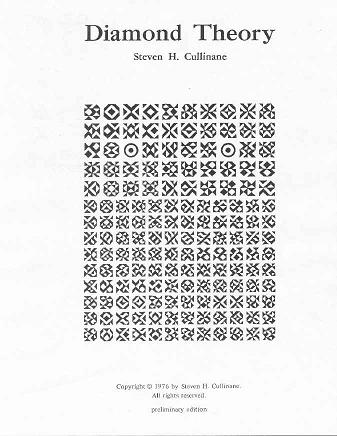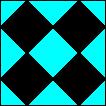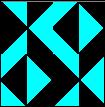Diamond
|
|

Motto of |
| Related sites: The 16 Puzzle Bibliography On the author |
Diamond
|
|

Motto of |
Symmetry is often described as invariance under a group of transformations. An unspoken assumption about symmetry in Euclidean 3-space is that the transformations involved are continuous.Diamond theory rejects this assumption, and in so doing reveals that Euclidean symmetry may itself be invariant under rather interesting groups of noncontinuous (and asymmetric) transformations. (These might be called noncontinuous groups, as opposed to so-called discontinuous (or discrete) symmetry groups. See Weyl's Symmetry.)
For example, the affine group A on the 4-space over the 2-element field has a natural noncontinuous and asymmetric but symmetry-preserving action on the elements of a 4x4 array. (Details)
By embedding the 4x4 array in a 4x6 array, then embedding A in a supergroup that acts in a natural way on the larger array, one can, as R. T. Curtis discovered, construct the Mathieu group M24 -- which is, according to J. H. Conway, the "most remarkable of all finite groups."
The proof that A preserves symmetry involves the following elementary, but useful and apparently new, result: Every 4-coloring (i.e., every map into a 4-set) can be expressed as a sum of three 2-colorings. It is conceivable that this result might have applications other than to diamond theory. (Details)
The proof that A preserves symmetry also yields some insight into orthogonality of Latin squares, at least in the 4x4 case. In this case, orthogonality turns out to be equivalent to skewness of lines in a finite projective 3-space. (Details)Diamond theory provides simple ways to visualize
- "the simplest non-trivial model for harmonic analysis,"1 the Walsh functions,
- "the smallest perfect universe,"2 the finite projective space PG(3,2),
- the "distinguished geometry," "remarkable geometric individual," and "gem,"3 the finite projective plane PG(2,4),
- the "remarkable"4 outer automorphisms of S6, and
- the structural equivalence of certain
- factorizations3 of graphs,
- parallelisms5 of partitions,
- spreads6 of lines, and
- sets of mutually orthogonal squares (i.e., n-orthogonal7 n×n matrices).
1. F. Schipp et al., Walsh Series, 1990
2. Burkard Polster, website
3. A. Beutelspacher in the American Mathematical Monthly, January 1986
4. P. J. Cameron and J. H. van Lint, Designs, Graphs, Codes, and their Links, 1991
5. P. J. Cameron, Parallelisms of Complete Designs, 1976
6. J. W. P. Hirschfeld, Finite Projective Spaces of Three Dimensions, 1985
7. J. Denes and A. D. Keedwell, Latin Squares and their Applications, 1974As a bonus, extending the action of A to a 4x4x4 array yields a simple way of generating the 1.3 trillion transformations natural to the 64 hexagrams of the I Ching. (Details)

On Euclid's
Elements:
"In view of... admiration the Elements has
consistently elicited over the years, and of the
prestigious role it concomitantly maintained until the
mid-19th century as scientific archetype, it is not
surprising that we find in the history of philosophy a
concept of truth sustained by the example of the
Elements, whose influence in philosophy runs
parallel to that of the Elements in science. This
concept I will call the 'Diamond Theory' of truth."
-- Richard J. Trudeau in The Non-Euclidean
Revolution, 1987
The image below shows the cover of a booklet I wrote in 1976. The booklet details the implications of what I call the "diamond theorem," after the diamond figure in Plato's Meno dialogue. This website, which updates the booklet, is written for mathematicians and college students of mathematics. For a less technical treatment of philosophical and literary matters related to the diamond theorem, see The Diamond Theory of Truth.

The
Diamond 16 Puzzle
Theme and Variations
Geometry of
the 4x4 Square
Galois
Geometry
Block
Designs
Geometry of the
I Ching
Solomon's
Cube
A
Mathematician's Aesthetics
The
Non-Euclidean Revolution.
This 1987 book by Richard J. Trudeau, with a brief
introduction by H. S. M. Coxeter, traces in the recent
history of geometry the conflict between what Trudeau calls
the "Diamond Theory of truth" and the "Story
Theory of truth" -- known to more traditional
philosophers as "realism" and "nominalism."
For more on Trudeau's version of diamond theory, see this site's companion website, The Diamond Theory of Truth.
For more on the story theory, consider the following quotation:
"The moral of my story is: Read Euclid and ask questions. Then teach a course on Euclid and later developments arising out of these questions."
The quotation is from Robin Hartshorne, the author of Algebraic Geometry, in "Teaching Geometry According to Euclid," Notices of the American Mathematical Society, April 2000.
Plato tells how Socrates helped Meno's slave boy "remember" the geometry of a diamond. Twenty-four centuries later, this geometry has a new theorem.
|
|||||||||
|
The 2x2 case In the 2x2 case, D is a one-diamond figure (top left, below) and G is a group of 24 permutations generated by random permutations of the four 1x1 quadrants. Every G-image of D (as below) has some ordinary or color-interchange symmetry. |

|
|
Example of the 4x4
case In the 4x4 case, D is a four-diamond figure (left, below) and G is a group of 322,560 permutations generated by arbitrarily mixing random permutations of rows and of columns with random permutations of the four 2x2 quadrants. Every G-image of D (as at right, below) has some ordinary or color-interchange symmetry. |
||
 D |
Let e denote transposition of the first two rows, f denote transposition of the last two columns, g denote transposition of the top left and bottom right quadrants, and h denote transposition of the middle two columns. Then Defgh is as at right. Note that Defgh has rotational color-interchange symmetry like that of the famed yin-yang symbol. |
 Defgh |
|
Remarks on the 4x4
case: G is isomorphic to the affine group A on the linear 4-space over GF(2). The 35 structures of the 840 = 35 x 24 G-images of D are isomorphic to the 35 lines in the 3-dimensional projective space over GF(2). Orthogonality of structures corresponds to skewness of lines. We can define sums and products so that the G-images of D generate an ideal (1024 patterns characterized by all horizontal or vertical "cuts" being uninterrupted) of a ring of 4096 symmetric patterns. There is an infinite family of such "diamond" rings, isomorphic to rings of matrices over GF(4). For a movable JavaScript version of these 4x4 patterns, see The Diamond 16 Puzzle. |
||
The statement of the theorem may be clarified by a research announcement written in 1978 that illustrates the above 4x4 example in reverse... Research Announcement, 1978.
For an artist's rendering of some patterns generated as described in the diamond theorem (and many not so generated), see the following new (September 11, 2000) website: Tiling, by Mike Lyon.
For more illustrations and a sketch of the proof, see the following
Hartshorne's principle: "Whenever one approaches a subject from two different directions, there is bound to be an interesting theorem expressing their relation." - Robin Hartshorne, AMS Notices, April 2000, p. 464.
Plato's Diamond in the Meno
Plato as a precursor of Gerard Manley Hopkins's "immortal
diamond." An illustration shows the prototype of the figure
D discussed above.
Plato's
Diamond Revisited
Ivars Peterson's Nov. 27, 2000 column "Square of the
Hypotenuse" which discusses the diamond figure as used by
Pythagoras (perhaps) and Plato. Other references to the use
of Plato's diamond in the proof of the Pythagorean
theorem:
"We may say, roughly, that a mathematical idea is
'significant' if it can be connected, in a natural and
illuminating way, with a large complex of other
mathematical ideas."
- G. H. Hardy, A Mathematician's Apology (1940),
Cambridge University Press, reprinted 1969, page
89
affine geometry, affine planes, affine spaces, automorphisms, binary codes, block designs, classical groups, codes, coding theory, collineations, combinatorial, combinatorics, conjugacy classes, the Conwell correspondence, correlations, Cullinane, R. T. Curtis, design theory, the diamond theorem, diamond theory, duads, duality, error correcting codes, exceptional groups, finite fields, finite geometry, finite groups, finite rings, Galois fields, generalized quadrangles, generators, geometry, GF(2), GF(4), the (24,12) Golay code, group actions, group theory, Hadamard matrices, hypercube, hyperplanes, hyperspace, incidence structures, invariance, Karnaugh maps, Kirkman's schoolgirls problem, Latin squares, Leech lattice, linear groups, linear spaces, linear transformations, Mathieu groups, matrix theory, Meno, Miracle Octad Generator, MOG, multiply transitive groups, octads, the octahedral group, orthogonal arrays, outer automorphisms, parallelisms, partial geometries, permutation groups, PG(3,2), Plato, Platonic, polarities, Polya-Burnside theorem, projective geometry, projective planes, projective spaces, projectivities, Reed-Muller codes, the relativity problem, Singer cycle, skew lines, Socrates, sporadic simple groups, Steiner systems, Sylvester, symmetric, symmetry, symplectic, synthemes, synthematic, tesseract, transvections, Walsh functions, Witt designs
The
Combinatorics Net
The
Open Directory list of combinatorics sites
U. of
London Permutation Groups Resources
U.
of London Design Resources on the Web
Diamond Theory Bibliography |
The generalized Walsh functions
On the Walsh functions
Walsh series: an introduction to dyadic harmonic analysis
Review of the book Walsh Series and Transforms,
by Golubov, et al.
Walsh series and transforms
Transitive Erweiterungen endlicher Permutationsgruppen
Combinatorial theory
Permutation groups
Permutation groups and combinatorial structures
(London Math. Soc. lecture note series, 23)
Math 555: Theory of Finite Groups (PDF)
Mathieu groups
The Mathieu groups and designs (PDF)
Special linear groups generated by transvections
and embedded projective spaces (PDF)
Some groups generated by transvection subgroups
Another simple proof for the existence of the
small Witt design (PDF)
Walsh-Hadamard transforms: A literature survey
Shift register sequences (Revised edition)
Designs, graphs, codes and their links
Orthogonal arrays: Theory and applications
Group theory and generalizations
Projective and polar spaces
A permutation decoding of the Golay code
A new construction of binary Golay code (24,12,8) using
a group algebra over a finite field
Lecture notes for Math6406, Combinatorial Structures
Bibliography for projective geometry
Symmetries of cultures
Symmetries in physics: new reflections
Bibliography of works on symmetry (72 items)
Mathematics in art and architecture
Symmetry (Annotated bibliography)
Linear groups with an exposition of the Galois theory
Finite geometries and their automorphisms -- Classical groups
The geometry of the classical groups
As it might have been
Reconstructing simple group actions
Bibliography of mutually orthogonal Latin squares
A theorem in finite projective geometry and some applications
to number theory
Design theory, Volume I (Encyclopedia of mathematics and
Its applications , Vol. 69)
Design theory, Volume II (Encyclopedia of mathematics and
Its applications, Vol. 78)
CRC handbook of combinatorial designs
Mutually orthogonal Latin squares (MOLS)
Mutually orthogonal Latin squares: A brief survey of constructions
The CRC handbook of combinatorial designs (1995 website)
Markings of the Golay code
Visual mathematics
International Society for the Interdisciplinary Study of
Symmetry (ISIS-Symmetry)
The recent generalizations of colored symmetry
The mathematical theory of plane chromatic ornaments
Symmetry in science and art
Colored symmetry
Symmetry and ornament
Bibliography on symmetry
Walsh functions bibliography - Part I - Theory
Walsh functions bibliography - Part II - Applications
Lattices, linear codes, and invariants, Part II (PDF)
Lattices, linear codes, and invariants, Part I (PDF)
What is coding theory?
MA 3218 Coding Theory
Mathematical BBS (Excellent math portal at U. of Ferrara)
Walsh functions and their applications
A note on the Mathieu groups
Notes on digital coding
On the Mathieu group M24 and related topics
On representations of the Mathieu groups as collineation groups
Finite projective spaces of three dimensions
Projective geometries over finite fields
Latin squares and their applications
Finite permutation groups
A representation of the Mathieu group M24 as a collineation group
M24 and certain automorphic forms
The simple groups related to M24
A characterization of the alternating groups of degree 8 and 9
La geometrie des groupes classiques
The maximal subgroups of M24
Combinatorial configurations
Finite primitive permutation groups: A survey
Classical codes as ideals in group algebras
Niemeier lattices, Mathieu groups, and finite groups of
symplectic automorphisms of K9 surfaces
The subgroup structure of the finite classical groups
Codes from affine permutation groups
Decoding the ternary Golay code
Intersection of the Steiner systems of M24
Geometric interpretations of the 'natural' generators of
the Mathieu groups
Natural constructions of the Mathieu groups
Further elementary techniques using the Miracle Octad Generator
Orbit and coset analysis of the Golay and related codes
The geometry and cohomology of the Mathieu group M12
Geometry and symmetry
The sense of order
Geometric algebra
A characterization of designs related to the Witt system S(5,8,24)
The Mathieu groups
Decoding the Golay codes
On the construction of the Steiner system S(5,8,24)
t-designs from the large Mathieu groups
On the Mathieu groups M22, M23, M24, and the uniqueness of the
associated Steiner systems
A combinatorial construction of the small Mathieu designs and groups
Decoding the binary Golay code with miracle octad generators
The Steiner system S(5,6,12), the Mathieu group M12, and the "kitten"
Eight octads suffice
Der wunderschone Oktaden-Generator
Perfect codes and the Mathieu groups
Memoire sur la nombre de valeurs que peut acquirer une fonction....
Stereoscopic animated hypercube
The geometry of the Mathieu groups (PDF)
(Ch. 9 of Projective and polar spaces)
The subgroups of M24, or how to compute the table of marks
of a finite group
Finite geometry after Aschbacher's theorem: PGL(n,q)
from a Kleinian viewpoint
The Mathieu groups and their geometries (PDF)
Hidden angular momenta
Research Index
A history of finite simple groups
Constructing the isomorphism of A8 with GL(4,2) (PDF)
An introduction to Golay codes
Quotations related to combinatorics
Design Foundation (Chapter 11) (PDF)
Codes on graphs (PDF)
Program for making quilt-pattern designs
Coding theory and its application to the theory of sphere packing
The tetrahedral Golay code (PDF)
Tiling in PostScript and METAFONT -- Escher's Wink (PDF)
Singer cycles (An introduction to the applications of
geometry in cryptography)
Constructions of the Golay codes -- A survey (PDF)
Problems and lecture notes on the Polya-Burnside
enumeration theorem (PDF)
The Tiling Patterns of Sebastien Truchet....
Methode pour faire une infinité de desseins differents avec
des carreaux ....
Truchet & types: tiling systems and ornaments
The Art of Kenneth A. Huff
Coloriage de pavage dit
Tiling patterns derived from Truchet tile
The classical groups
PermGroup
The point-hyperplane design 2-(15, 7, 3)
Sur la fonction cinq fois transitive de 24 quantites....
Memoire sur l'etude des functions des plusieurs quantites.....
Permutation Groups
Uber Steinersche Systemen
Die 5-fach transitiven Gruppen von Mathieu
Permutation groups
The smallest perfect universe
Square of the hypotenuse
Meno
Dodecahedral faces of M12
Some thoughts on the number six
Generating the octad generator
Binary coordinate systems
Sphere packings, lattices, and groups
Twelve sporadic groups
Sporadic groups
Low rank representations and graphs for sporadic groups
Symmetry of the cube
The 3-space PG(3,2) and its group
21-6=15: A connection between two distinguished geometries
Modeling the 21-point plane with outer automorphisms of S6
Combinatorial mathematics
Cyclic projective planes
Projective geometry
Duality and symmetry: A matrix symmetrization problem
Generalized Steiner systems of type 3-(v, {4,6}, 1)
Introduction to the theory of groups of finite order
Tiling
The diamond theory of truth
The non-Euclidean revolution
Symmetry
From error-correcting codes through sphere packings to simple groups
The theory of error-correcting codes
The thirteen books of Euclid's elements, Volume I
Tilings and patterns
A mathematician's aesthetics
A new combinatorial approach to M24
Diamond theory
Symmetry invariance in a diamond ring (A.M.S. abstract 79T-A37)
Diamond theory
Three lectures on exceptional groups
Parallelisms of complete designs
"It is a good light, then, for those
That know the ultimate Plato,
Tranquillizing with this jewel
The torments of confusion."
- Wallace Stevens,
Collected Poetry and Prose, page 21,
The Library of America, 1997
Home-page address of the author is http://www.m759.com.

URL address of this page on the net is http://m759.freeservers.com.
Page last updated July 17, 2004; created June 21, 2000.